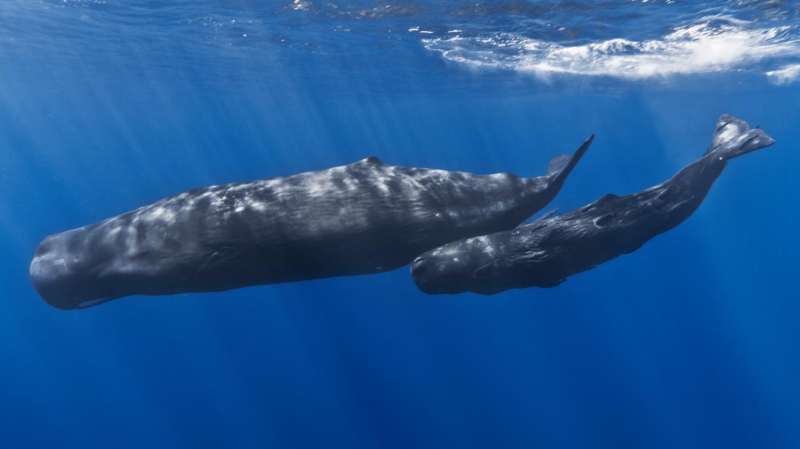September 14, 2016 report
Study suggests Japan falsified catch lengths of sperm whales in 60's and 70's

(Phys.org)—A pair of researchers with the Marine Mammal Laboratory, Alaska Fisheries Science Center has published a scathing report on Japanese whaling actives during the period 1960 to 1975. Phillip Clapham and Yulia Ivashchenko claim in their paper published in Royal Society Open Science that they have found evidence of widespread falsifying of whale length by Japanese whalers causing unknown damage to whale populations and putting in doubt current whale census data.
As the research pair note, prior research efforts have already revealed that Japanese whalers engaged in extensive illegal killing of sperm whales in northern parts of the Pacific Ocean during the 1960s. In this new effort, the researchers claim they have compelling evidence that suggests Japanese whalers were also illegally killing sperm whales in the Southern Hemisphere during the same time frame.
The evidence came, the researchers report, from data on illegal Russian activities during the same time period courtesy of a man named Dmitry Tormosov—he came into possession of true catch records on over 57,000 whales taken by Soviet whalers and processed at the Yuri Dolgorukiy factory and kept them hidden in his basement for several decades. Once the cold war ended, he felt safe in releasing them. The take numbers indicated that the Soviet whalers consistently lied on official reports about the length of female sperm whales they harvested. In comparing the official report data with the true data from Tomosov's list, the researchers found that out of 5,536 female sperm whales harvested, only 153 of them were actually above the legal limit set by the International Whaling Commission. The researchers suggest that such reporting makes it impossible to believe that out of 5,799 female sperm whales harvested by Japanese whalers over the same time period, 98.5 percent of them were of the legal length or longer as was officially reported. This very clearly shows, the researchers claim, that Japanese whalers were lying on many if not most of their reports. The researchers also note that the numbers of female sperm whales that met the legal length requirements harvested after the observer rules were implemented dropped to 9.1 percent, another indication the prior records had been falsified.
The falsehoods by both the Soviets and Japanese regarding the numbers of illegally taken whales prior to implementation of the International Observer Scheme, the researchers add, is very likely causing overestimations regarding current census numbers which are based on past catch data. For that reason, they suggest all scientific endeavors moving forward disregard current sperm whale population estimates.
More information: Phillip J. Clapham et al. Stretching the truth: length data highlight falsification of Japanese sperm whale catch statistics in the Southern Hemisphere, Royal Society Open Science (2016). DOI: 10.1098/rsos.160506
Abstract
Falsification of reports on Japanese catches of sperm whales (Physeter macrocephalus) is known to have occurred at both land whaling stations and in North Pacific factory fleets. Here, we conduct an analysis of pelagic sperm whale catches in the Southern Hemisphere: we compare true Soviet length data from the Yuri Dolgorukiy factory fleet during 1960–1975 to data for the same period reported to the International Whaling Commission (IWC) by Japan. Prior to implementation of the International Observer Scheme (IOS) in 1972, the Soviet fleet killed 5536 females, of which only 153 (2.8%) were at or above the minimum legal length of 11.6 m. During the same period, Japan killed 5799 females and reported that 5686 (98.5%) were of legal size, with 88.5% of the entire length distribution reported as being between 11.6 and 12.0 m. This unrealistic distribution, together with the fact that Japanese fleets were supposedly able to catch 37 times the number of legal-sized females as the Soviet fleet, indicates extensive falsification of catch data by Japan. Further evidence of misreporting is that females >11.5 m dropped to 9.1% of the Japanese catch after 1971, when the IOS made cheating much more difficult. That 99.6% of 10 433 males in the pre-IOS catch were also reported to be of legal size, indicates that illegal catches were not confined to females. We caution that the Japanese sperm whale data in the IWC Catch Database are unreliable and should not be used in population assessments. The ease with which illegal catches were apparently made underscores the past failures of the IWC to effectively regulate whaling.
Journal information: Royal Society Open Science
© 2016 Phys.org




















